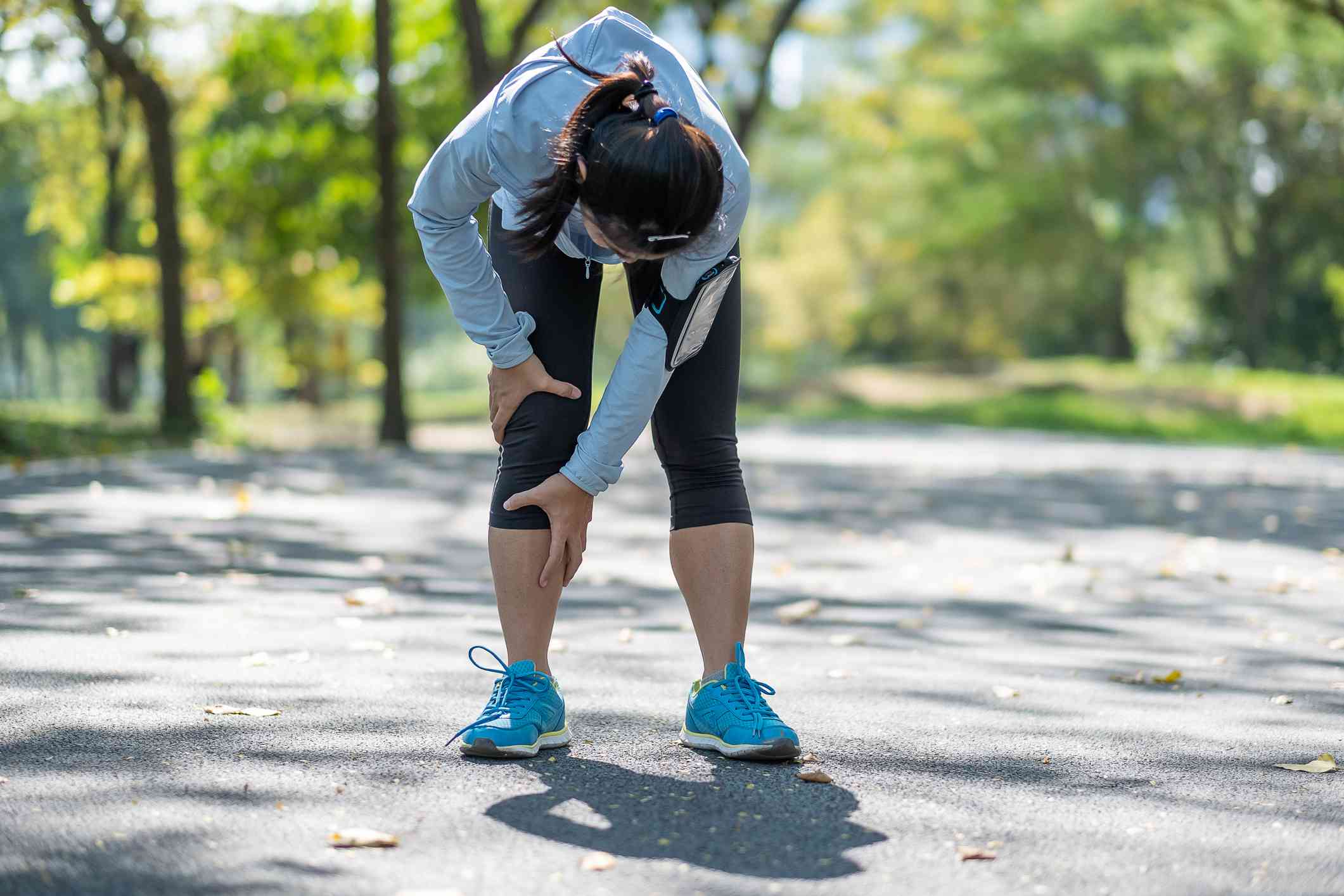

Featured
Why Does My Knee Hurt When Jogging
Modified: October 24, 2023
Get expert advice on why your knee hurts when jogging. Our featured article covers common causes, tips for prevention, and effective treatment options.
Introduction
Are you experiencing knee pain every time you go out for a jog? If so, you’re not alone. Knee pain while jogging is a common complaint among runners of all levels, from beginners to seasoned athletes. It can range from minor discomfort to sharp, debilitating pain that hinders your ability to continue running.
Understanding the causes of knee pain when jogging is crucial in order to find appropriate solutions and avoid further injury. In this article, we will explore various factors that can contribute to knee pain during jogging and provide tips on how to prevent and treat this discomfort.
It’s important to note that knee pain can be attributed to a variety of factors, and the information provided here is intended for informational purposes only. It should not replace the advice and guidance of a medical professional.
Now, let’s dive into the potential causes of knee pain during jogging and discover ways to alleviate this issue, allowing you to enjoy your runs once again.
Causes of Knee Pain When Jogging
Knee pain while jogging can be attributed to various factors, ranging from overuse and repetitive stress injuries to incorrect running technique. Understanding the causes of knee pain is essential to address the issue effectively. Here are some common culprits:
- Overuse and repetitive stress injuries: Jogging puts repetitive strain on your knees, which can lead to overuse injuries such as patellofemoral pain syndrome, iliotibial (IT) band syndrome, and runner’s knee. These conditions often develop gradually due to the consistent impact and movement patterns associated with jogging.
- Incorrect running technique: Running with improper form can place unnecessary stress on your knees. Issues such as overstriding, heel striking, and inadequate knee alignment can contribute to knee pain. It’s important to ensure proper running technique to minimize the risk of injury.
- Weak or imbalanced muscles: Weak or imbalanced thigh muscles, especially the quadriceps (front of the thigh) and hamstrings (back of the thigh), can disrupt the stability of the knee joint. This can lead to increased stress on the knee during jogging and contribute to pain and discomfort.
- Excess body weight: Carrying excess weight puts additional stress on the joints, including the knees. This can increase the risk of knee pain during jogging. Losing weight in a healthy and sustainable way can help alleviate this stress and reduce knee pain.
- Improper footwear: Wearing inappropriate or worn-out running shoes can contribute to knee pain. Shoes that lack proper support, cushioning, or stability can lead to improper foot and leg alignment, increasing the strain on the knees. Choosing the right footwear for your running needs is crucial to prevent knee problems.
These are just a few of the potential causes of knee pain while jogging. It’s important to remember that everyone’s body is unique, and individual factors may contribute to your specific discomfort. Identifying the underlying cause of your knee pain can help implement appropriate preventive measures and targeted treatment.
Overuse and Repetitive Stress Injuries
Overuse and repetitive stress injuries are common causes of knee pain when jogging. The repetitive nature of jogging can lead to excessive strain on the knee joint and surrounding structures, resulting in various types of injuries. Here are some of the most common overuse and repetitive stress injuries:
- Patellofemoral Pain Syndrome (PFPS): Also known as “runner’s knee,” PFPS causes pain around the kneecap. It’s often a result of the repetitive motion and impact of jogging, leading to irritation and inflammation of the patellofemoral joint.
- Iliotibial (IT) Band Syndrome: The iliotibial band is a thick band of connective tissue that runs along the outside of the thigh, from the hip to the shin. IT band syndrome occurs when this band becomes tight or inflamed, causing pain on the outside of the knee. It is often caused by the repetitive friction between the iliotibial band and the femur during jogging.
- Patellar Tendonitis: Also known as jumper’s knee, this condition involves inflammation and irritation of the patellar tendon, which connects the kneecap to the shinbone. Repetitive stress on this tendon during jogging can lead to pain and tenderness below the kneecap.
- Meniscus Tears: The meniscus is a rubbery cartilage in the knee joint that acts as a shock absorber. Overuse and repetitive stress can cause small tears or damage to the meniscus, resulting in knee pain, swelling, and instability.
These injuries often develop gradually over time, as the repetitive motions and impact of jogging place strain on the knee joint. It’s important to listen to your body and recognize the early signs of overuse injuries. If you experience persistent or worsening knee pain, it’s crucial to take a break from jogging and seek appropriate treatment.
Treating overuse and repetitive stress injuries usually involves a combination of rest, ice, compression, and elevation (RICE), along with targeted exercises and physical therapy to improve strength and flexibility. It’s essential to consult with a healthcare professional to determine the best course of treatment for your specific injury.
Incorrect Running Technique
Running with incorrect technique can put unnecessary strain on your knees, leading to pain and discomfort. It’s important to maintain proper form while jogging to minimize the risk of knee problems. Here are some common running technique mistakes that can contribute to knee pain:
- Overstriding: Overstriding occurs when your foot lands too far ahead of your body’s center of gravity. This leads to a braking effect, causing excessive impact on your knees and increasing the risk of injury. Strive for a shorter stride length and aim to land your feet closer to your body to reduce the strain on your knees.
- Heel Striking: Landing on your heel with each stride can create a jarring impact on your knees. Ideally, you should aim for a midfoot or forefoot strike, where your foot makes contact with the ground with the midfoot or ball of the foot first. This helps absorb shock more efficiently and reduces stress on the knees.
- Inadequate Knee Alignment: Proper knee alignment is essential for maintaining balance and minimizing strain on the joints. When running, make sure your knees are in alignment with your feet, avoiding any inward or outward deviation. This helps distribute the forces evenly and reduces the risk of knee pain and injuries.
Improving your running technique takes time and practice. Focus on increasing your cadence (number of steps per minute) and maintaining an upright posture to optimize your form. Consider working with a running coach or joining a running group to receive guidance and feedback on your technique.
In addition to correcting your running form, it’s important to build strength and flexibility in the muscles surrounding your knees. Incorporating exercises such as lunges, squats, and leg raises can help strengthen your quadriceps, hamstrings, and glutes, providing better support and stability to your knees.
By paying attention to your running technique and making necessary adjustments, you can reduce the risk of knee pain and enhance your overall running experience.
Weak or Imbalanced Muscles
Weak or imbalanced muscles can contribute to knee pain when jogging. The muscles surrounding the knee joint play a crucial role in providing stability and absorbing impact during physical activities. When these muscles are weak or imbalanced, it can result in increased stress on the knees. Here’s a look at some key muscle groups that can impact knee stability:
- Quadriceps (front of the thigh): The quadriceps muscles are responsible for straightening the knee and absorbing shock during activities like jogging. If these muscles are weak, the knee joint may be less stable, leading to increased stress and potential pain.
- Hamstrings (back of the thigh): The hamstrings work in conjunction with the quadriceps to provide stability and control during running. If the hamstrings are weak or imbalanced in relation to the quadriceps, it can affect the mechanics of the knee joint and contribute to knee pain.
- Hip muscles: The glutes and hip abductor muscles are important for maintaining proper alignment and stability of the legs and knees during jogging. Weakness or imbalances in these muscles can cause the knees to collapse inward or outward, increasing the risk of knee pain and injury.
To address weak or imbalanced muscles, it’s important to incorporate strength training exercises into your routine. Focus on exercises that target the quadriceps, hamstrings, glutes, and hip muscles. Some effective exercises include squats, lunges, step-ups, hip bridges, and clamshells.
In addition to strength training, stretching exercises can help improve flexibility and prevent muscle imbalances. Be sure to stretch your quadriceps, hamstrings, and hip muscles regularly to maintain optimal muscle length and balance.
If you’re unsure about proper exercise technique or need guidance in developing a strength training program, consider consulting a fitness professional or physical therapist. They can provide personalized recommendations based on your specific needs and help you address any muscle weaknesses or imbalances that may be contributing to your knee pain.
Excess Body Weight
Excess body weight is a common factor that can contribute to knee pain while jogging. Carrying extra weight puts added stress and pressure on the joints, including the knees. The impact of jogging can be significantly amplified for individuals who are overweight or obese. Here’s how excess body weight can affect your knees:
- Increased force on the knee: Excessive body weight places a greater load on the knee joint with each step. This can lead to accelerated wear and tear on the joint, potentially resulting in pain, inflammation, and conditions such as osteoarthritis.
- Imbalance and misalignment: Excess weight can disrupt the natural alignment of the body, placing uneven stress on the joints. This imbalance can strain the ligaments, tendons, and muscles around the knees, leading to discomfort and potential injury.
- Reduced shock absorption: The excess weight can impair the body’s ability to absorb shock, which is crucial during activities like jogging. This lack of shock absorption places excessive strain on the knees, increasing the risk of pain and injury.
Managing a healthy body weight is important not only for overall health but also for reducing the risk of knee pain during jogging. If you are overweight or obese and struggling with knee pain, losing weight can help alleviate the strain on your knees. But it’s essential to take a gradual and sustainable approach to weight loss.
Adopting a well-rounded program that combines healthy eating, regular exercise, and behavior modification is key. Consider incorporating cardiovascular exercises, such as walking or swimming, to decrease impact on the knees while still promoting weight loss. Additionally, strength training exercises can help build muscle mass, which can aid in better joint support and stability.
It’s important to consult with a healthcare professional or a registered dietitian who can provide personalized guidance and support on weight management strategies. They can help create a plan that suits your specific needs, taking into account your overall health, lifestyle, and any underlying conditions.
Improper Footwear
The footwear you choose for jogging plays a significant role in preventing knee pain. Wearing improper or worn-out shoes can contribute to knee discomfort and increase the risk of injury. Here are some ways in which footwear can impact your knees:
- Lack of support: Insufficient arch support and cushioning in your shoes can lead to poor shock absorption and increased impact on your knees. Without proper support, the knees may absorb more of the stress from jogging, leading to pain and potential injuries.
- Inadequate stability: Shoes with inadequate stability features can affect the alignment of your feet, ankles, and knees. Inadequate stability can cause your feet to roll inward or outward excessively, placing added strain on the knee joint and increasing the risk of pain and injury.
- Poor fit: Shoes that do not fit properly can cause issues such as friction, pressure points, and blisters, which can lead to knee discomfort. Ill-fitting shoes can also interfere with your natural gait and disrupt the biomechanics of your lower body, potentially leading to knee pain.
To prevent knee pain caused by improper footwear, it’s crucial to wear shoes that are specifically designed for running or jogging. Here are some tips for selecting appropriate footwear:
- Choose shoes with good arch support and cushioning to provide shock absorption and reduce the impact on your knees.
- Select shoes that offer adequate stability and motion control to help maintain proper foot and knee alignment during jogging.
- Ensure that the shoes fit properly, with enough room in the toe box and a snug fit around the heel to prevent slipping and discomfort.
- Consider getting your gait analyzed by a professional to determine if you have any specific biomechanical needs, such as pronation or supination, that require additional support or corrective features in your shoes.
- Replace your jogging shoes regularly, typically every 300-500 miles or when they show signs of wear and tear. Worn-out shoes can lose their cushioning and support, increasing the risk of knee pain.
Investing in high-quality, well-fitting running shoes is essential for maintaining proper foot and knee alignment, reducing the risk of knee pain, and enjoying a comfortable jogging experience.
Prevention and Treatment of Knee Pain
Preventing and treating knee pain when jogging involves a combination of practices aimed at reducing strain on the knees and promoting their health and strength. Here are some strategies to help prevent and alleviate knee pain:
- Warm-up and stretching exercises: Prior to jogging, it’s important to warm up your muscles and joints with dynamic exercises to increase blood flow and flexibility. Follow it up with gentle stretching exercises that target the muscles around the knee, such as quadriceps and hamstrings, to improve their flexibility and reduce the risk of injury.
- Strengthening exercises: Engaging in regular strength training exercises, focusing on the muscles around the knees, can provide stability and support to the joint. Exercises such as squats, lunges, and leg presses can help improve muscle strength and reduce stress on the knees.
- Cross-training and rest days: To avoid overuse injuries and allow your knees time to recover, incorporate cross-training activities into your routine. Alternate jogging with low-impact exercises like swimming or cycling. Additionally, incorporate rest days into your schedule to give your knees a break and facilitate recovery.
- Proper running form and technique: Pay attention to your running technique, maintaining good posture, and ensuring proper foot strike and knee alignment. Consider working with a running coach or joining a running group to receive guidance and feedback on your form.
- Using supportive footwear: Invest in high-quality running shoes that provide adequate cushioning, arch support, and stability. Replace them regularly to ensure optimal support and shock absorption for your knees.
- Healthy weight management: Maintaining a healthy body weight can significantly reduce the stress on your knees during jogging. Incorporate a balanced diet and regular exercise to achieve and maintain a healthy weight range.
- Seeking medical advice and treatment options: If you experience persistent or worsening knee pain, it’s important to consult with a healthcare professional. They can assess the severity of your condition and recommend appropriate treatment options, such as physical therapy, pain management techniques, or in some cases, surgery.
Remember, every individual is different, and what works for one person may not work for another. It’s important to listen to your body, be mindful of any discomfort or pain, and make necessary adjustments to your routine. Taking proactive measures to prevent knee pain and addressing it promptly can help you enjoy comfortable and injury-free jogging sessions.
Warm-up and Stretching Exercises
Prior to engaging in any physical activity, including jogging, it’s essential to properly warm up your muscles and joints. Warming up prepares your body for exercise by increasing blood flow, raising your body temperature, and loosening up tight muscles. This helps reduce the risk of injury and enhances your overall performance. Incorporating stretching exercises into your warm-up routine can further improve flexibility and prevent muscle imbalances that can contribute to knee pain. Here are some warm-up and stretching exercises to consider:
- Walking or slow jogging: Start your warm-up with a brisk walk or slow jog to gradually increase your heart rate and warm up the muscles throughout your body. This helps loosen up stiff joints and prepare your body for more intense activity.
- Dynamic stretches: Perform dynamic stretches that mimic the movements of jogging. This can include exercises such as leg swings, high knees, butt kicks, and walking lunges. Dynamic stretches help improve joint range of motion and promote better muscle activation.
- Quadriceps stretch: Stand upright and hold onto a stationary object for support. Bend one knee, bringing the heel towards your glutes. Grab your ankle or foot with your hand and gently pull it closer to your buttocks until you feel a stretch in the front of your thigh. Hold for 20-30 seconds and repeat with the other leg.
- Hamstring stretch: Stand tall with one foot slightly in front of the other. Keeping your back straight, hinge forward at the hips and reach down towards your toes. Hold for 20-30 seconds and repeat with the other leg. You should feel a gentle stretch in the back of your thigh.
- Calf stretch: Stand facing a wall and place your hands on the wall for support. Step one foot back and keep it straight, with the heel firmly planted on the ground. Gently lean forward, keeping your back leg extended, until you feel a stretch in your calf. Hold for 20-30 seconds and switch to the other leg.
Performing dynamic stretches before jogging helps warm up your muscles by taking them through a full range of motion. This promotes better blood circulation and prepares your muscles for the repetitive motions involved in jogging. Static stretches, like quadriceps, hamstrings, and calf stretches, are best performed after your jog or during your cooldown to help improve flexibility and prevent muscle tightness.
Keep in mind that stretching should never be painful. If you experience any discomfort or pain, ease off the stretch or consult with a qualified professional for guidance. Remember to listen to your body and tailor your warm-up and stretching routine to your specific needs and comfort level.
Strengthening Exercises
Engaging in regular strengthening exercises is crucial for maintaining strong and stable muscles around the knees. Strengthening these muscles can help prevent knee pain and injuries by improving joint stability and absorbing impact during activities like jogging. Here are some effective strengthening exercises for your knees:
- Quadriceps exercises: Strengthening the quadriceps muscles at the front of your thighs can provide better stability and support for your knees. Squats, lunges, and leg presses are great exercises to target the quadriceps. Start with bodyweight exercises and gradually add resistance as your strength improves.
- Hamstring exercises: Strong hamstrings at the back of your thighs help balance the muscle strength around the knee joint. Incorporate exercises such as hamstring curls using resistance bands or machines, as well as deadlifts and glute bridges to target the hamstrings effectively.
- Glute exercises: Strong glute muscles play a significant role in maintaining proper alignment and stability of the knees. Exercises like hip thrusts, squats, and step-ups can help activate and strengthen the glutes, reducing strain on the knees.
- Calf exercises: Strengthening the calf muscles can enhance the overall stability of the lower legs. Exercises like calf raises, both in a seated and standing position, can effectively target the calves and improve their strength and endurance.
- Balance exercises: Incorporating balance exercises into your routine can help train the smaller stabilizing muscles around the knees. Try exercises like single-leg balances, side leg lifts, or standing on an unstable surface to challenge your balance and improve joint stability.
When performing strengthening exercises, it’s important to maintain proper form and ensure that the targeted muscles are engaged. Start with lighter weights or resistance and gradually increase as your strength improves. Aim to include strength training exercises for your knees at least two to three times a week, allowing for adequate rest and recovery between sessions.
Remember to listen to your body and avoid pushing beyond your limits. If you experience pain or discomfort during any exercise, adjust the range of motion or consult with a qualified fitness professional or physical therapist for guidance.
Incorporating a well-rounded strength training program that targets all the major muscle groups of your lower body can help improve overall strength and stability, reducing the risk of knee pain and ensuring a more enjoyable jogging experience.
Cross-training and Rest Days
Engaging in cross-training activities and incorporating rest days into your exercise routine are essential strategies to prevent knee pain and promote overall joint health. Cross-training allows you to vary your workouts, giving your knees a break from the repetitive impact of jogging while still maintaining fitness. Rest days, on the other hand, provide your body with the necessary time to recover and repair. Here’s why cross-training and rest days are important:
- Reduced impact on the knees: Cross-training activities such as swimming, cycling, or using an elliptical machine provide excellent cardiovascular benefits with less impact on the knees compared to jogging. This helps give your knees time to recover from the stress of repetitive pounding.
- Muscle balance and flexibility: Engaging in cross-training activities allows you to target different muscle groups and movement patterns, promoting overall muscular balance and preventing muscle imbalances that can contribute to knee pain. Additionally, incorporating activities like yoga or Pilates on rest days can improve flexibility and promote better joint mobility.
- Injury prevention: Cross-training helps to reduce the risk of overuse injuries by giving specific muscle groups utilized in jogging a chance to rest and recover. It also allows you to identify any weaknesses or imbalances that may be contributing to knee pain and address them proactively.
- Recovery and repair: Rest days are vital for your overall recovery. They allow your body to repair damaged tissues, replenish energy stores, and adapt to the stress of training. Giving your knees a break on rest days helps reduce inflammation and promotes healing.
When incorporating cross-training activities into your routine, aim for at least two to three days per week of activities that are lower impact than jogging. This allows you to maintain cardiovascular fitness while minimizing strain on your knees.
Additionally, be mindful of including rest days in your schedule. Ideally, aim for at least one to two days of complete rest every week, giving your body ample time to recover and rejuvenate. On rest days, you can engage in light activities such as gentle stretching, foam rolling, or leisurely walks to promote blood flow and aid in recovery.
Remember, everybody is different, and the optimal balance between jogging, cross-training, and rest days may vary. It’s important to listen to your body, pay attention to any signs of fatigue or pain, and adjust your routine accordingly. Consulting with a fitness professional or coach can also help you develop a well-rounded training plan that suits your goals and needs.
Proper Running Form and Technique
Maintaining proper running form and technique is essential for preventing knee pain and optimizing your performance while jogging. Good running form helps distribute the impact forces more efficiently throughout your body and reduces the strain on your knees. Here are some key elements of proper running form to consider:
- Posture: Maintain an upright posture throughout your run. Keep your head up, look forward, and avoid slouching or hunching your shoulders. This helps align your body and minimize unnecessary strain on your knees.
- Footstrike: Aim to land with a midfoot or forefoot strike, as opposed to a heel strike. Landing on your midfoot or forefoot allows for better shock absorption and promotes a more natural and efficient running motion, reducing the impact on your knees.
- Cadence: Strive for a higher cadence, which refers to the number of steps you take per minute. A higher cadence helps reduce the strain on your knees by shortening your stride length and promoting quicker turnover. Aim for a cadence of around 180 steps per minute.
- Arm swing: Maintain a relaxed arm swing, with your arms bent at a 90-degree angle. Your arm swing should be coordinated with your leg movements, helping maintain balance and rhythm while running.
- Knee alignment: Ensure that your knees are in alignment with your feet during each stride. Avoid excessive inward or outward movement of your knees, as this can lead to unnecessary stress and increase the risk of knee pain.
- Breathing: Focus on maintaining a steady and controlled breathing pattern during your run. Take deep breaths, using your diaphragm, to ensure proper oxygen flow and prevent muscle tension that can contribute to knee discomfort.
Correcting and maintaining proper running form requires practice and awareness. Start by incorporating short intervals of focused running form drills into your training sessions. Gradually increase the duration and frequency of these drills as you become more comfortable.
It can also be helpful to work with a running coach or join a running group to receive guidance and feedback on your form. They can provide valuable insights and offer specific tips and techniques to improve your running mechanics.
Remember, everyone’s running form is unique, and what works for one person may not work for another. It’s important to find a balance that feels comfortable and natural for you while still adhering to the core principles of good running form. By maintaining proper running form, you can reduce the risk of knee pain and enhance your overall running experience.
Using Supportive Footwear
Choosing the right footwear is crucial for preventing knee pain and ensuring a comfortable and safe jogging experience. Supportive footwear plays a significant role in providing the necessary cushioning, stability, and protection for your knees. Here are some important considerations when selecting and using supportive footwear for jogging:
- Arch support: Look for shoes that offer adequate arch support. The arch of your foot acts as a shock absorber, and proper support can help distribute the forces evenly across your feet and legs, reducing the strain on your knees.
- Cushioning: Opt for shoes with ample cushioning, especially in the heel and forefoot areas. Good cushioning helps absorb the impact of jogging, reducing the stress on your knees and providing a more comfortable running experience.
- Stability features: Consider shoes with stability features, such as a firmer midsole or additional support structures. These features can help control excessive foot pronation (inward rolling) or supination (outward rolling) and promote proper alignment, reducing the risk of knee pain and injuries.
- Proper fit: It’s essential to choose running shoes that fit properly. Ill-fitting shoes can lead to discomfort, friction, and potential injuries. Ensure that there is enough room in the toe box to wiggle your toes, and the shoes provide a secure yet comfortable fit around your heels and midfoot.
- Replace when necessary: Pay attention to the wear and tear of your shoes. Over time, the cushioning and support of running shoes can degrade, diminishing their effectiveness. As a general guideline, consider replacing your shoes every 300-500 miles or when you notice signs of significant wear and tear.
When trying on running shoes, it’s advisable to visit a specialty running store where trained staff can provide guidance and help you find the right shoe for your specific needs. They may analyze your gait and foot structure to recommend shoes that align with your biomechanics.
Keep in mind that while supportive footwear is important, it’s not a miracle solution for all knee issues. It should be used in conjunction with other preventive measures such as proper running form, adequate warm-up, and strength training exercises.
Remember, each person’s feet and running style are unique, so what works for someone else may not work for you. It may take some trial and error to find the perfect pair of running shoes that suit your specific requirements and provide optimal support for your knees.
By investing in well-fitting, supportive running shoes, you can reduce the strain on your knees, minimize the risk of knee pain, and enjoy a more comfortable and enjoyable jogging experience.
Healthy Weight Management
Maintaining a healthy body weight is an important factor in preventing knee pain while jogging. Carrying excess weight puts additional stress on the knees, increasing the risk of discomfort and potential injury. Managing your weight through a combination of a balanced diet and regular exercise can have significant benefits for your overall joint health. Here are some key considerations for healthy weight management:
- Proper nutrition: Adopting a balanced, nutrient-rich diet can help you achieve and maintain a healthy weight. Focus on consuming a variety of fruits, vegetables, whole grains, lean proteins, and healthy fats. Limit the intake of processed foods, sugary beverages, and unhealthy fats.
- Portion control: Pay attention to portion sizes and practice mindful eating. Be aware of your hunger and fullness cues, and aim for balanced meals that include appropriate portions of protein, carbohydrates, and fats to support your energy and nutritional needs.
- Regular exercise: Engage in regular physical activity to support weight management. In addition to jogging, include other forms of exercise such as strength training, cardiovascular workouts, and flexibility exercises. Variety in your exercise routine can help burn calories, build muscle, and improve overall fitness levels.
- Gradual weight loss: If you need to lose weight, aim for a gradual and sustainable approach. Losing weight too quickly can put additional stress on your body and increase the risk of muscle loss. Aim to lose 1-2 pounds per week by creating a calorie deficit through a combination of diet and exercise.
- Seek professional guidance: Consulting with a registered dietitian or nutritionist can provide personalized guidance on healthy weight management. They can help create a tailored meal plan, offer strategies for behavior change, and provide ongoing support to help you achieve your weight loss goals.
It’s important to recognize that healthy weight management is not solely focused on achieving a specific number on the scale. It’s about adopting a lifestyle that promotes overall health and wellbeing. At the same time, it’s crucial to have realistic expectations and realize that your body weight may not necessarily correlate with your ability to be a successful and enjoyable jogger.
Remember, a healthy weight is unique to each individual. Focus on nourishing your body with nutritious foods, staying active, and making sustainable lifestyle changes that support your overall health rather than solely fixating on a number on the scale. By maintaining a healthy weight, you are helping to reduce the strain on your knees during jogging and promoting a healthier and more comfortable exercise experience.
Seeking Medical Advice and Treatment Options
If you’re experiencing persistent or severe knee pain while jogging, it’s important to seek medical advice. A healthcare professional can assess your condition, provide an accurate diagnosis, and recommend appropriate treatment options. Here are some reasons why seeking medical advice is crucial:
- Accurate diagnosis: A healthcare professional can evaluate your symptoms, medical history, and perform diagnostic tests if necessary to determine the underlying cause of your knee pain. Identifying the specific cause can help guide the most appropriate treatment approach.
- Personalized treatment plan: Based on the diagnosis, a healthcare professional can develop a personalized treatment plan tailored to your needs. Treatment options may include a combination of conservative management, such as physical therapy, medication, or lifestyle modifications, or in some cases, surgical intervention.
- Pain management: If your knee pain is impacting your quality of life or hindering your ability to exercise, a healthcare professional can provide strategies to manage pain. This may include recommendations for pain medications, non-pharmacological interventions, or referrals to pain management specialists if necessary.
- Prevention of worsening condition: Seeking medical advice early can prevent a minor knee problem from developing into a more severe condition. Early intervention through proper treatment and management can help optimize your recovery and prevent further damage to your knees.
- Individualized guidance: Each person’s situation is unique, and what works for one individual may not work for another. Consulting with a healthcare professional allows you to receive personalized guidance and support based on your specific condition, medical history, and lifestyle factors.
A healthcare professional, such as an orthopedic specialist or sports medicine doctor, has the expertise and knowledge to guide you through the appropriate treatment options. They can help you determine whether interventions such as physical therapy, bracing, corticosteroid injections, or surgery may be necessary depending on the severity and underlying cause of your knee pain.
Remember, prompt medical attention is crucial for accurate diagnosis and effective treatment. Delaying seeking medical advice may result in prolonged pain or complications. A healthcare professional can help you navigate the best course of action and support you in achieving your goals of pain-free jogging and optimal knee health.
Conclusion
Knee pain when jogging can be frustrating and limiting, but with the right knowledge and strategies, it can be managed effectively. Addressing the causes of knee pain, adopting preventive measures, and seeking appropriate treatment can help you overcome this hurdle and continue enjoying your runs.
Understanding the potential causes of knee pain, such as overuse injuries, improper running technique, weak muscles, excess body weight, and improper footwear, allows you to take steps to mitigate these factors. Implementing warm-up and stretching exercises, engaging in strengthening workouts, incorporating cross-training activities, maintaining proper running form, choosing supportive footwear, and managing a healthy body weight are all key preventive measures.
Additionally, seeking medical advice is crucial if you experience persistent or severe knee pain. A healthcare professional can provide an accurate diagnosis, personalized treatment options, and guidance tailored to your specific needs. They can help you manage pain effectively, prevent further complications, and guide you towards a successful recovery.
Remember, everyone’s journey is unique. It may take time to find the right combination of strategies that work best for you. Be patient, listen to your body, and make adjustments as needed. By understanding the causes of knee pain and implementing preventive measures, you can continue to pursue your jogging goals while keeping your knees healthy and pain-free.









